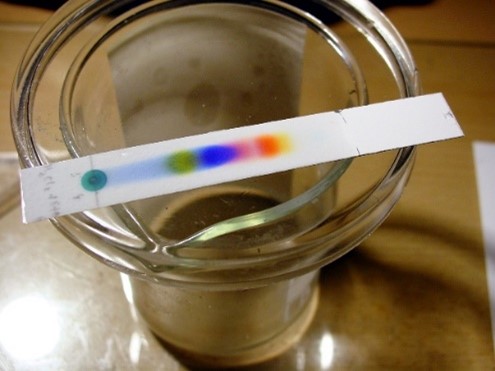 After reading part 1 of this series, What is Chromatography, learn more here about how chromatography works.
After reading part 1 of this series, What is Chromatography, learn more here about how chromatography works.
A simple introduction to chromatography involves placing a spot of dye on a stationary phase using thin layer chromatography.
In TLC, the stationary phase is a piece of paper designed for the task, or a glass or plastic plate coated with a thin layer of silica gel. The mobile phase is a solvent. Common solvents include water, ethanol (used in many hand sanitizers and medical wipes, antiseptics, and disinfectants), methanol (found in antifreeze), acetone (a common component in nail polish remover), dichloromethane (paint stripper), or a mixture of two or more. For this experiment, we'll use hexane and ethyl acetate as the mobile phase.
Watch the following video to see how TLC is used to separate the various compounds in some dye.
 To learn more, a great source is Let Us Teach Proper Thin Layer Chromatography Technique! by Jack Silver, applications chemist with Teledyne ISCO, originally published in the Journal of Chemical Education.
To learn more, a great source is Let Us Teach Proper Thin Layer Chromatography Technique! by Jack Silver, applications chemist with Teledyne ISCO, originally published in the Journal of Chemical Education.
In addition to TLC, chemists use instruments from Teledyne ISCO to achieve extremely accurate, reliable, cost-effective and green chromatography results using a variety of methods. We'll investigate a few of those in our next blogs in this series.
- A step up from TLC: Flash Chromatography
- After that, learn about High-Performance Liquid Chromatography and Supercritical Fluid Chromatography
For more information on our Chromatography products, visit https://www.teledyneisco.com/chromatography or contact us
